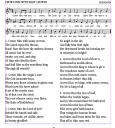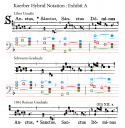Fleur de lys Hymnal : by Koerber : Now Available
-
Thanks for chiming in RM.
You have started the proof reading process!
It's all going to proof soon... this has just been my own doing at this point. No proofing has been done at all.
If one wishes to have numbers, they can be easily added. If one doesn't want folk music it can easily be deleted. Our institution wants a community hymnal and songbook, hence, the content. I am simply making this effort available to the public with the ability to alter the contents to your liking. However, I do have limitations to what content I will put into a custom printing. -
This hymnal is going to print as I have my first order (cloth cover)
The official title is:
Fleur-de-lys Hymnal

 Screen Shot 2022-11-18 at 5.22.21 PM.png745 x 1117 - 73KThanked by 1CHGiffen
Screen Shot 2022-11-18 at 5.22.21 PM.png745 x 1117 - 73KThanked by 1CHGiffen -
Thanked by 1CHGiffen
-
Is there a link where we can order a copy?
-
The typo in the thread title raises the question of how one goes about proofreading such a large collection, something I'm always curious about anyway.
I'm not in the market in any case for "Dixie" and 'Swanee River' to the exclusion of Battle Hymn of the Republic. -
@Richard_Mix
(I fixed the thread title)
All the English hymn text was taken from the cyberhymnal website and all the Latin was generated from Gregobase.
Secular songs were gotten from lyric websites.
Truly, the main bulk of MY work was setting the initial verse of each hymn in which the verse is copied and pasted using the lyric tool in Sibelius… (look ma.., no typing)! [takes about two minutes to create the initial verse of each hymn.]
Since the entire layout is accomplished with InDesign, it is very easy to edit, add, delete and rearrange pages and or sections. Using the style tool, ID automatically generates a table of contents. (I did type the titles, so there could be an error in there somewhere ;), however, I did run a spell check on the entire work once it was completed.
Not sure I answered your question.
As for customization, I can add selections and delete selections without too much trouble having worked in the publications industry for the last 30 years and it's all so second nature I suppose... hymnal only took about three weeks to put together.
@ServiamScores
This hymnal is created solely print on demand, and therefore I have no stock of individual copies. (I have two of my own copies from the first edition). I can, however, allow you to see a sample of pages by taking a video. Minimum order for the book binder is 10 copies at $25 per book (paperback). Of course if you’re ordering hundreds of copies for a Parish, the price goes down significantly.
@et_al
The biggest part of this project will be setting everything to SATB, which I will mostly scoop from the 1940 since those harmonizations are truly the best. I will probably use the NOH for the chant accomps possibly using my hybrid notation method. (http://myopus.com/preview/layoutDemo01.pdf), however, these are labor intensive and very time consuming.
All criticism, suggestions, corrections are welcome!
I DID NOT employ hymn numbers... I always find it confusing... use page numbers on the hymn board... if there are two hymns on one page, people will quickly figure it out. CAVEAT: If you WANT hymn numbers I can include them for a small fee! :}
Also, everything is arranged alphabetically, so if you want to find Joy to the World, go to the J's! -
Gots to get me one of deez!
Great work!!!
Gaudete in Domino Semper!Thanked by 1francis -
Francis - can you post a sample of this hymnal's "Crown Him with Many Crowns" ?
Many thanks -
here you go

 Screen Shot 2023-05-05 at 11.06.15 AM.png696 x 778 - 110K
Screen Shot 2023-05-05 at 11.06.15 AM.png696 x 778 - 110K
 Screen Shot 2023-05-05 at 11.06.31 AM.png690 x 1066 - 137KThanked by 1mmeladirectress
Screen Shot 2023-05-05 at 11.06.31 AM.png690 x 1066 - 137KThanked by 1mmeladirectress -
A number of people are asking if I would make a choir edition. Yes. That is next.
However, in a choir edition (SATB mostly taken from the 1940 and the English Hymnal) I would also include chant accompaniments utilizing an innovation of hybrid notation. (see sample below)
For keeping track of a developing concept, I am tagging this Hybrid Notation Exhibit A.
This allows for more accurate reading and directing of the chant by an organist by maintaining the official Gregorian Notation above the accompaniment in a single bass staff. I have been trying to hone this approach and here are yesterday's results.
1. employs the official (probably Solemnes) edition in the chant line of the 1961 Graduale.
2. introduces colored notes for the three voices in the organ (ATB) in a single bass clef staff. (eliminating the need for many ties)
2. introduces a new note design (square) that optimizes the space needed to write organ music without the excessive bulge of round modern notes. (eliminates crowding which a significant problem with modern notation in general)
3. employs the Nova Organi Harmonia rendition of chant accompaniment that is superb in its use of polyphonic modal technique.
4. condenses pages of chant accompaniment from approximately 3 to 1. (less page turning for an organist)

 Screen Shot 2024-02-03 at 12.17.53 PM.png1270 x 1302 - 253K
Screen Shot 2024-02-03 at 12.17.53 PM.png1270 x 1302 - 253K -
Thanked by 1CHGiffen
Welcome to the MusicaSacra Forum!
To participate in the discussions on Catholic church music, sign in or register as a forum member, The forum is a project of the Church Music Association of America.
Categories
- All Discussions21,110
- General Music Discussion8,218
- Job Openings197
- Management of Music Programs850
- Choral Matters533
- Church Documents and Rubrics524
- CMAA Notes302
- Events716
- For Newcomers: Read First26
- Sacred Polyphony546
- Hymnody872
- Gregorian Chant: General2,698
- ↳ Graduale Romanum and Liber Usualis368
- ↳ Graduale Simplex60
- ↳ Semiology63
- Vernacular Plainsong696
- Anglican Use and Anglican Chant68
- Organ, Other Instruments and Repertoire435
- New Composition/Works in Progress1,291
- Recordings232
- Music for Hispanic Ministry159
- Music Education: Children211
- Music Education: General222
- News Items245
- Positions Wanted2
- General Discussion: Catholicism739
- Amusements177
- General Discussion1,034
- Opinions117

